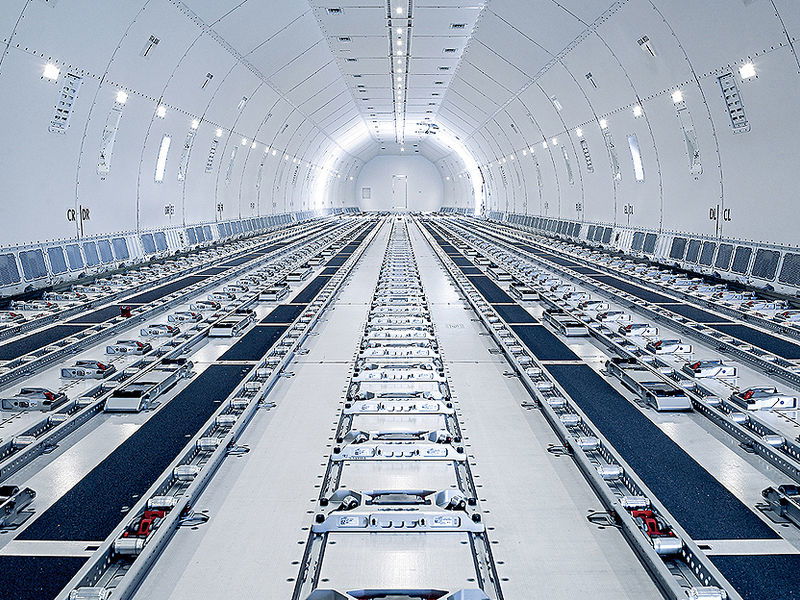The range capability of the Boeing 777/F provides significant savings for cargo operators. It enables them to take advantage of fewer stops and associated landing fees, less congestion at transfer hubs, lower cargo handling costs, and shorter cargo delivery times. The new freighter also integrates smoothly with existing cargo operations and facilitates interlining with 747 freighter fleets.
The Boeing 777/F has been specifically designed as a freighter, with additional strengthening in key structural areas, including:
- New monolithic aluminum floor beams.
- Rigid cargo barrier located in the forward section of the airplane.
- Strengthened fuselage, especially in the area of the main deck cargo door.
Other design enhancements include:
- Enhanced, lightweight cargo-handling system with built-in test equipment that continually monitors the operational health of the system.
- Modified environmental control system.
- An advanced maneuver load alleviation system that redistributes the aerodynamic load on the wing during non-normal flight conditions, reducing the load on its outboard portion (see fig. 2). This allows the 777F to operate in a wide variety of flight environments without compromising payload capability.
With a maximum takeoff weight of 766,000 pounds (347,450 kilograms), the 777F has a revenue payload capability of more than 226,000 pounds (102.8 metric tons). It can fly 4,880 nautical miles (9,038 kilometers) with a full payload at general cargo market densities (more than 10 pounds per cubic foot), making it the world’s longest-range twin-engine freighter (see fig. 4).
The airplane has been engineered to have essentially the same landing characteristics as the 777-200LR (Longer Range), despite a maximum landing weight that is nearly 17 percent heavier (575,000 pounds; 260,810 kilograms).
The Boeing 777/F accommodates 27 standard pallets (96 by 125 inches; 2.5 by 3.1 meters) on the main deck. The industry-standard 10-foot-high (3-meter-high) pallets are accommodated by the large main deck cargo door.
Full Specifications
| Crew | 2 | |
| Propulsion | 2 Turbofan Engines | |
| Engine Model | General Electric GE90-110B1 | |
| Engine Power (each) | 492,7 kN | 110760 lbf |
| max. Cruise Speed | 896 km/h | 484 kts 557 mph |
| Mmo (max. Mach) | Mach 0.84 | |
| Service Ceiling | 13.137 m | 43.100 ft |
| Range | 9.047 km | 4.885 NM 5.622 mi. |
| Empty Weight | 144.379 kg | 318.300 lbs |
| max. Takeoff Weight | 347.815 kg | 766.800 lbs |
| max. Landing Weight | 260.816 kg | 575.000 lbs |
| Wing Span | 64,80 m | 212 ft 7 in |
| Wing Area | 427,8 m² | 4605 ft² |
| Length | 63,73 m | 209 ft 1 in |
| Height | 18,99 m | 62 ft 4 in |
| First Flight | 14.07.2008 | |
| Production Status | in production | |
| Developed from | Boeing 777-200LR | |
| ICAO Code | B77L | |
| IATA Code | 77F | |
| FAA TCDS | T00001SE | |
| EASA TCDS | IM.A.003 | |
| Data for (Version) | Boeing 777F | |
Photos




